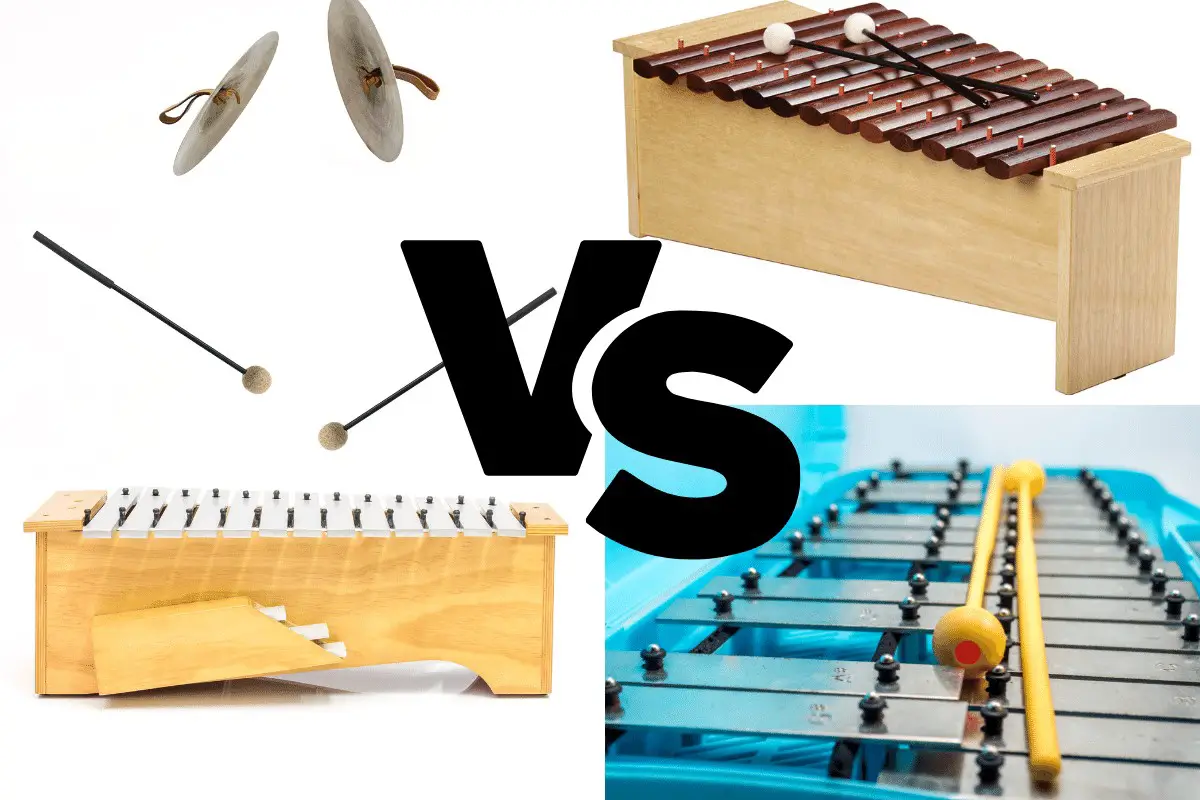In the elementary music classroom, we tend to call all barred instruments either Orff instruments or xylophones.
But this isn’t strictly true.
There are three main variations we use, and figuring out the xylophone vs. metallophone vs. glockenspiel differences is tricky.
The difference between xylophones, metallophones, and glockenspiels are the material the bars are made from. Xylophones are made of wood, metallophones of metal, and glockenspiels are metal and smaller than metallophones.
Let’s look into some examples and direct comparisons in the rest of the article.
Disclaimer: Links to products may be affiliate in nature, which means we earn a small commission if you click and buy at no extra cost to you. Thanks for the support!

Save time with these 60 FREE Music Resources to use in your room right away!
Stop searching the whole internet to find good activities. I’ll help you cut to the chase with my favorite 60 FREE resources.
Table of Contents
Xylophone Vs. Metallophone Vs. Glockenspiel Comparison Chart
| Quality | Xylophone | Metallophone | Glockenspiel |
|---|---|---|---|
| Percussion | Pitched Percussion | Pitched Percussion | Pitched Percussion |
| Material of the bars | Wood | Metal | Metal |
| Range | Low to high | Low to middle | High |
| Price | Low to middle | Low to middle | Middle to high |
| Types | Bass, Alto, Soprano, Professional | Bass, Alto, Soprano | Soprano |
| Use | Elementary to professional | Elementary | Elementary to professional |
Xylophone Example And Description
Xylophone’s name tells you all there is to know.
“Xylo-” literally translates to wood.
“-phone” means sound.
Put it together, and what do you get? Wood sound!
In some cheaper xylophones, synthetic wood (type of plastic) is used, but this often cheapens the instrument.
Fiberglass has also become even more popular as a material. It’s lighter, cheaper, and more durable.
On the elementary music side of things, xylophones have a great mellow sound compared to most other instruments you’ll use.
Further Reading: FREE xylophone lesson plans
It comes in several sizes.
The soprano xylophone plays higher notes, the alto xylophone is in the middle, and the bass xylophone is one the low end.
There are even bass bars or contrabass bars, which are single bars, each with its own box or body.
As a tuba player by trade, I LOVE the bass tones these bad boys put out.
And the kids love to play them too!
Elementary xylophones tend to leave off the accidental or altered pitches, but they’ll send some of them along as individual bars to swap out to play in different keys.
The range of the elementary xylophone is typically between an octave and a fifth OR two octaves.
Alto and Bass xylophones are played with yarn mallets, while the soprano is played with rubber mallets.
Professional xylophones have a much larger range and a bigger sound, although they usually stick with the middle to high range.
A related instrument called a marimba has a richer sound and lower range (on top of the higher extended range, too!). They also feature tubes to help channel the sound, where the xylophone doesn’t.
They cost a lot more and don’t serve a useful purpose in the elementary music room.
But in middle school or high school and beyond? This is a must!

Metallophone Example And Description
Metallophones are one of those weird musical instruments that most elementary music teachers know but professional musicians don’t.
This is because they only serve a purpose in the elementary music room.
In the “real” music world, such as orchestral music, you’d use vibraphones to achieve a pitched percussion with a more metal sound.
Further Reading: What are Orff instruments?
This is a bit too much for younger students.
So essentially, teachers started taking the wood xylophone design for the younger kids, with its limited scale and pitches and made them out of metal.
Like the Orff xylophone for elementary, it comes in Bass, Alto, and Soprano sizes.
But it does NOT come in bass bar options.
The metal bars make the metallophones louder and less clean, so playing fast passages is a little tricky.
As such, soft mallets are a must with this percussive instrument.
They are also usually a little more expensive than similar-sized and quality xylophones.
Note: Metallophone is also the term used to describe ALL metal-based pitched percussion instruments, but this term isn’t used frequently in this way.
Most of the time, it’s just used to refer to the elementary music instrument.

Glockenspiel Example And Description
Glockenspiels are a German instrument of the pitched percussion variety.
They are used very specifically in pieces for their pure, high tone.
As such, it’s used in specific pieces, often at the high school level and beyond.
But it also shows up in the elementary classroom as part of the Orff Instrumentarium.
It’s a small instrument and plays in the high range.
In elementary, it won’t have the altered pitches (sharps and flats), but other than this, it’ll be and sound largely the same.
The bars are made of metal, typically steel or aluminum.
Like the other percussion instruments discussed in this article, it has 1.5 – 2 octaves of range.


Save time with these 60 FREE Music Resources to use in your room right away!
Stop searching the whole internet to find good activities. I’ll help you cut to the chase with my favorite 60 FREE resources.

